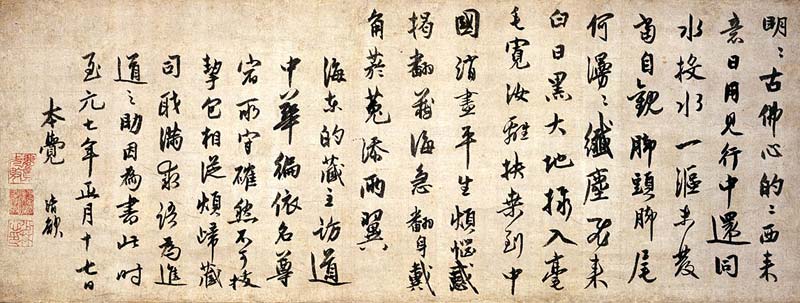Liao'an Qingyu (1288-1363) was a monk in the Yuan Dynasty. A native of Linhai, Taizhou (Zhejiang), his common surname is Zhu. The name is Liao'an and the name is Nantang. Famous overseas for his ink marks. Lost his father at the age of nine. At the age of 16, he became a monk from Huyan Jingfu and was saved by the Buddhist scriptures. Following the advice of Tibetan Master Xi Baiming, I went to Kaiyuan Temple in Suzhou to visit the ancient forest Qingmao, and then I understood and inherited his method. In the first year of Huangqing's reign (1312), when Qingmao lived in Kaiyuan Temple again, Shi Nai served as the admission attendant. Later, he returned to Jingshan and served as the head of the hall behind Xugu Xiling. In addition, after his teacher Qingmao moved into Jiankang Baoning Temple, he was assigned to the first seat. In the second year of Tianli (1329), Qingmao retired to Kaifu Temple in Pianshui. In the first year of Yuan Tong (1333), he moved to Benjue Temple in Jiaxing and lived there for ten years. At that time, he was respected as the Great Buddhist Dharma Tower in the Southeast. Many scholars and officials asked questions, and he was awarded a golden robe and the title of "Ciyun Puji Zen Master" by the emperor. . Retreat and hide in the south hall. In the fifth year of Zhizheng (1345), he once lived in Lingyan Temple in Wuzhong (Wuxian County, Jiangsu Province). Later, he was attacked by war and took refuge with his disciple Zu □. He retreated to Ciyun Temple, three miles north of Jili Pavilion. He passed away in August of the 23rd year of Zhengzheng, and lived for seventy-six years. The person who inherited the law was Mu'an Wenkang. The Teacher's Quotations includes nine volumes of Zen Master An Qingyu's quotations, quotations from Kaifu Temple in Zhongshan on Jiqing Road, quotations from Benjue Zen Temple on Jiaxing Road, quotations from Lingyan Zen Temple on Pingjiang Road, and Master Ying'an's French teachings written by Chijue Monk. Among the more famous ink marks are Yue Lin Dao Jiaoyu's ink on the twenty-fifth day of Jisi Teng lunar month, French's one on the seventeenth day of the first lunar month in the seventh year of the Yuan Dynasty, and the ink left by the Zhizheng Dinghai year. [Supplement to the Complete Works of the Scholar of the Song Dynasty, Volume 3 (Song Lian, Praise for the Portrait of Zen Master Nantang), Volume 6 of the Supplementary Biography of the Deng Record, Volume 11 of the Five Deng Yantong Collection, Volume 2 of the Continuation of Shi Shi's Ancient Records, Volume 1 of the Biography of the Patriarch of Ink Ink, Explanation of the Ink Ink in the Zen Forest ( Tianshan Fangnan)]

French, paper, running script, 27.7 x 73.3cm. Collection of Tokyo National Museum, Japan (gift from Matsudaira Naoryo)
When Liaoan Qingyuan came to Hongkakuji Temple, the head monk who came from Japan was practicing in his temple. When the Tibetan master finished his spiritual practice and was about to return home, Liao Anqing wanted to comply with his request and wrote this "French" for him on January 17, 1341. The life of the monk's Tibetan owner is unknown. The writing style of this piece is gentle and elegant, and we can see the influence of the calligraphy style of the Yuan Dynasty politician, calligrapher, painter, and poet Zhao Mengfu.








